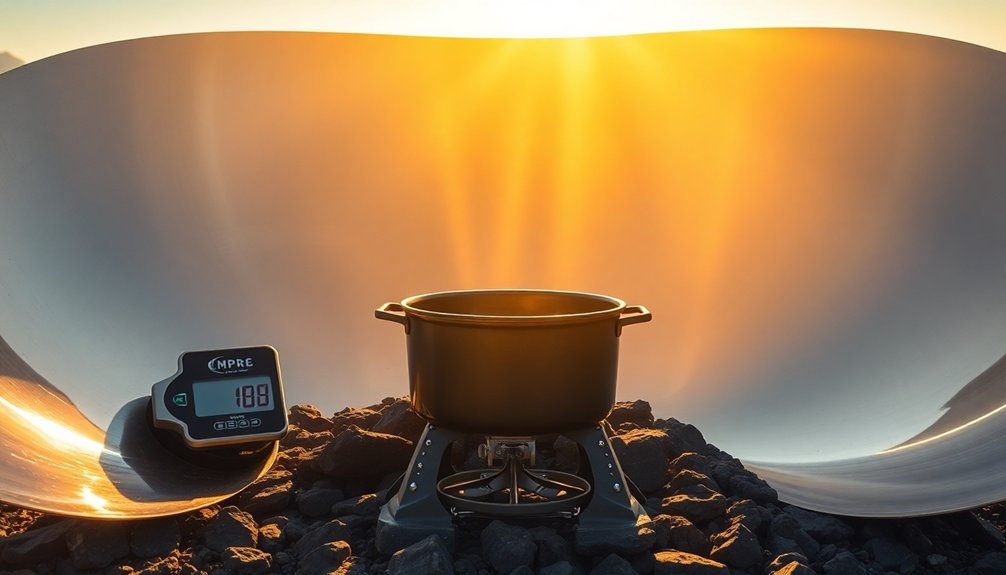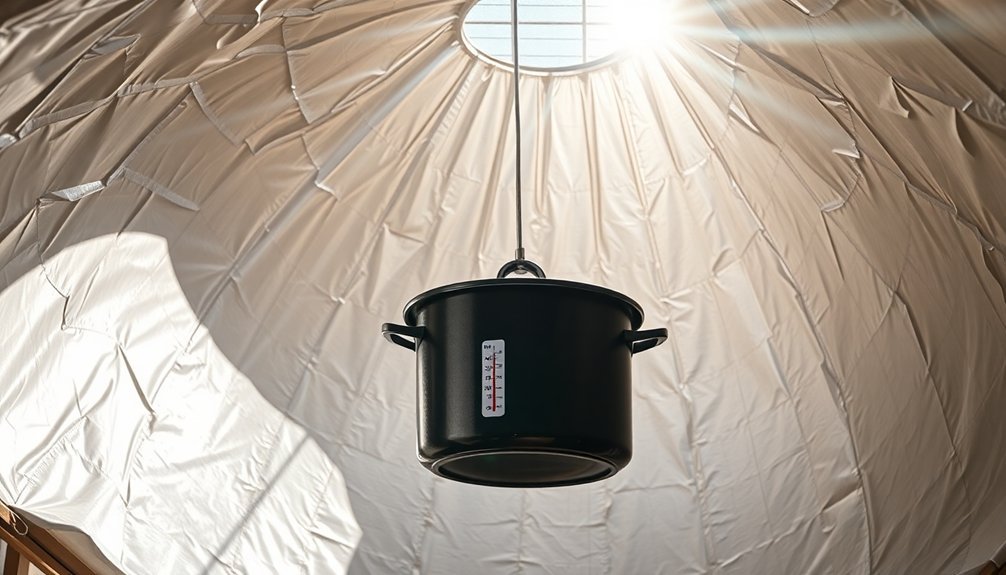You've likely experienced that frustrating moment when a gust of wind threatens to topple your solar oven, putting your outdoor meal at risk. Whether you're camping in the mountains or cooking in your backyard, stability can make or break your solar cooking experience. The latest 2025 stabilizer models offer innovative solutions to this common problem, and we'll show you exactly what features separate the exceptional from the ordinary in today's market.
Portable Solar Oven Deluxe with Cookware Set
The Portable Solar Oven Deluxe stands out as a practical solution for three types of outdoor enthusiasts: campers seeking lightweight cooking options, environmentally conscious cooks, and emergency preparedness advocates.
At just over a pound, you'll find it remarkably portable. The oven requires no assembly and includes everything you need: a thermometer, heat-conducting trays, dehydrating racks, and both enamelware and silicone pots. You'll appreciate its versatility – from baking cookies to drying fruits.
While it requires practice to master sun positioning, you'll get consistent results once you learn to align the oven's back seam with direct sunlight. Consider it your outdoor slow cooker, perfect for day-long meal preparation.
Best For: Outdoor enthusiasts, environmentally conscious individuals, and emergency preparedness planners who want a portable, fuel-free cooking solution for camping, hiking, or backup emergency cooking.
Pros:
- Extremely lightweight and portable at just over 1 pound with simple setup and storage
- Complete cookware set included with versatile cooking options (baking, dehydrating, slow cooking)
- No fuel required and environmentally friendly cooking method
Cons:
- Requires direct sunlight and proper positioning for effective cooking
- Significant learning curve to master temperature control and cooking times
- Some quality concerns with zipper durability and condensation issues
Factors to Consider When Choosing Solar Oven Stabilizers for Windy Conditions
When choosing a solar oven stabilizer for windy conditions, you'll want to check the weight distribution anchor points and guarantee the base material offers both durability and grip on various terrains. The stabilizer's wind-resistant shape design should effectively minimize wind resistance while maintaining peak sun exposure for your solar oven. Quick-release safety mechanisms are essential for rapid response to sudden weather changes, allowing you to quickly secure or remove your equipment as needed.
Weight Distribution Anchor Points
Strategic placement of weight distribution anchor points stands as a critical factor in choosing an effective solar oven stabilizer. You'll want to look for a stabilizer system that offers multiple anchor points around the base, allowing you to secure your solar oven firmly against wind disturbances.
When selecting your stabilizer, make certain it's compatible with heavy-duty anchoring materials like sandbags or stakes. These robust components will help maintain your oven's stability during unexpected gusts. The anchor points shouldn't just prevent tipping – they should also help you maintain proper sun orientation for ideal cooking performance.
Choose a stabilizer that distributes weight evenly across all anchor points. This balanced approach will enhance your oven's structural integrity and give you peace of mind while cooking outdoors, even in challenging weather conditions.
Base Material and Durability
Beyond anchor points, base material selection plays a fundamental role in your solar oven stabilizer's performance. You'll want to choose stabilizers made from heavy-duty plastic or metal that can withstand prolonged exposure to weather conditions while resisting rust, corrosion, and UV damage.
The material's weight matters considerably – heavier bases provide better stability against strong winds and reduce the risk of your solar oven tipping over. When selecting your stabilizer, look for models featuring anti-slip surfaces that maintain grip on various terrains. You'll also benefit from stabilizers with ground-anchoring capabilities, allowing you to secure them firmly on different surfaces.
Remember that durability isn't just about immediate strength – it's about long-term performance. Choose materials that won't degrade quickly to guarantee your stabilizer remains effective season after season.
Wind-Resistant Shape Design
Wondering how to protect your solar oven from unexpected gusts? The key lies in choosing a stabilizer that complements your oven's aerodynamic design. You'll want to look for low-profile shapes that naturally deflect wind while maintaining ideal sun exposure.
Your ideal stabilizer should work with rounded or dome-shaped ovens, as these configurations help air flow smoothly around the unit rather than creating resistance. Make sure the stabilizer extends the oven's base width, creating a broader foundation that prevents tipping in gusty conditions.
Consider models with built-in weight distribution systems or anchor points that you can secure to the ground. The best stabilizers are made from lightweight yet sturdy materials like reinforced aluminum or weather-resistant composites, letting you easily transport your setup while ensuring it stays put during use.
Terrain Adaptability Features
Whether you're cooking on rocky mountainsides or sandy beaches, your solar oven's stability depends heavily on its ability to adapt to diverse terrain. You'll want to look for stabilizers with adjustable height features that can compensate for uneven ground while maintaining your oven's ideal position.
The best stabilizers come with versatile anchoring systems that work effectively on multiple surfaces, from grass to gravel. They're built with weather-resistant materials that won't deteriorate from constant outdoor exposure. Choose models with a robust base design and sufficient weight to enhance stability, but make sure they're still manageable for quick setup and adjustments. During windy conditions, you'll appreciate stabilizers that let you make swift modifications without compromising the security of your solar oven's position.
Quick-Release Safety Mechanisms
Safety features can make or break your solar oven experience, especially when it comes to quick-release mechanisms. You'll want to look for stabilizers that incorporate tool-free clips or latches, allowing you to quickly disassemble or adjust your setup when unexpected winds arise.
The best stabilizers come with built-in fail-safe systems that automatically disengage under excessive force, protecting your oven from damage. When choosing your stabilizer, verify it includes mechanisms that prevent tipping and maintain stability during gusty conditions. You'll find that high-quality quick-release features not only enhance safety but also boost your confidence in using the solar oven across various outdoor settings. Look for designs that offer both secure attachment and swift disengagement options to maintain consistent cooking performance while prioritizing safety.
Portability Vs Stability Balance
Balancing portability with stability presents a significant challenge when selecting solar oven stabilizers for windy conditions. You'll need to weigh the benefits of heavier components that resist strong gusts against your need for easy transport and setup.
When choosing your stabilizer, look for designs that fold compactly while still providing robust wind resistance. You'll want a system that doesn't just perform well but also sets up quickly at your destination. Pay attention to the materials used – they should be durable enough to handle wind stress without adding unnecessary weight to your gear.
Don't forget to check that your chosen stabilizer won't cast shadows on the cooking surface. The best options will secure your oven firmly without compromising its ability to harness the sun's energy efficiently.
Frequently Asked Questions
Can Solar Ovens Work Effectively in Snowy or Freezing Conditions?
You'll find solar ovens can work in cold weather if there's direct sunlight, but they'll cook more slowly. Snow reflection can actually help, but freezing temperatures reduce efficiency and extend cooking times considerably.
How Long Does It Take to Heat up Compared to Conventional Ovens?
You'll find solar ovens typically take 30-60 minutes longer than conventional ovens to reach cooking temperature. For example, if your regular oven takes 20 minutes to preheat, expect 50-80 minutes with solar.
What Maintenance Is Required to Keep the Stabilizer System Working Properly?
You'll need to check the stabilizer's screws monthly, clean any debris from moving parts, and lubricate joints twice yearly. It's best to store it indoors when not in use to prevent rust.
Are Solar Oven Stabilizers Compatible With All Solar Cooker Brands?
You'll find most stabilizers are designed with universal mounting systems, but you'll need to check your cooker's specifications. Some brands require specific adapters, while others won't be compatible with stabilizers at all.
Can Stabilizers Be Retrofitted to Older Solar Oven Models?
You'll find that most solar oven stabilizers can be retrofitted to older models through universal mounting brackets and adjustable clamps. However, you'll want to check your oven's dimensions and attachment points for compatibility first.





Leave a Reply